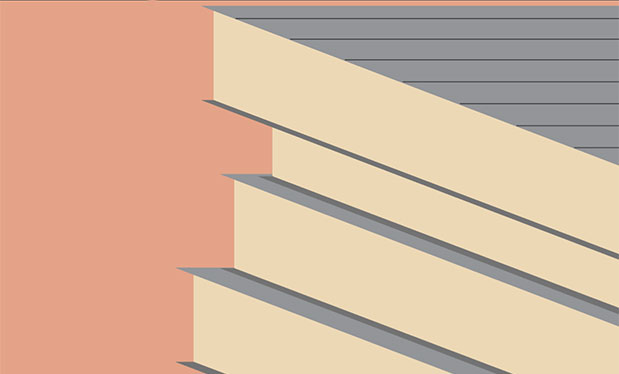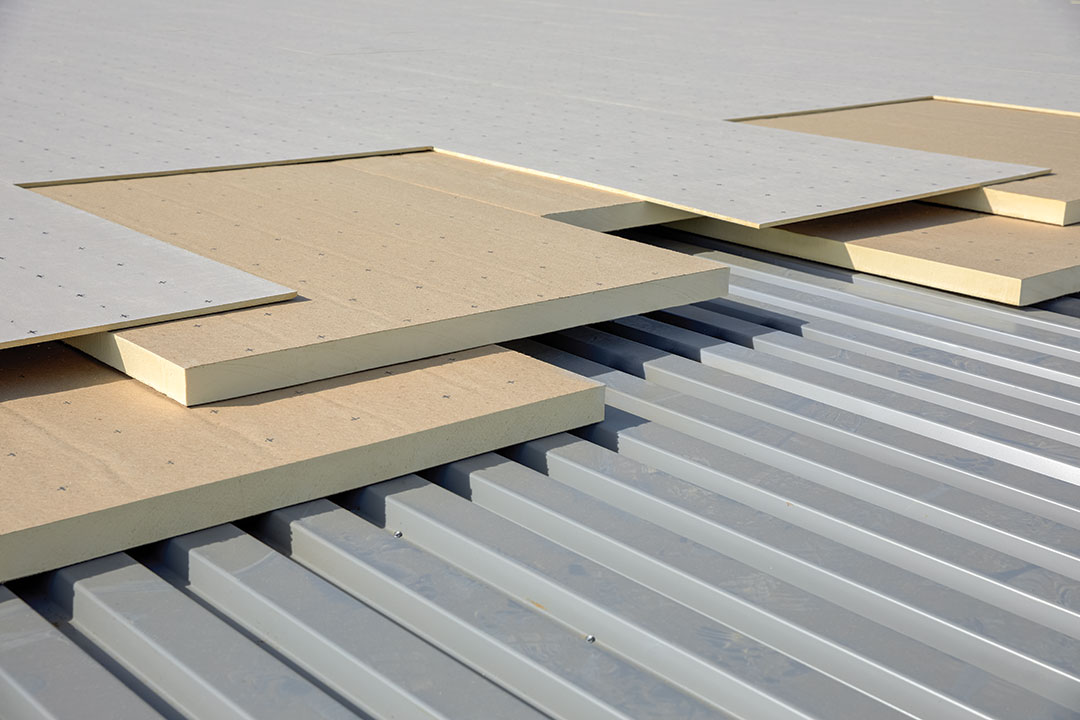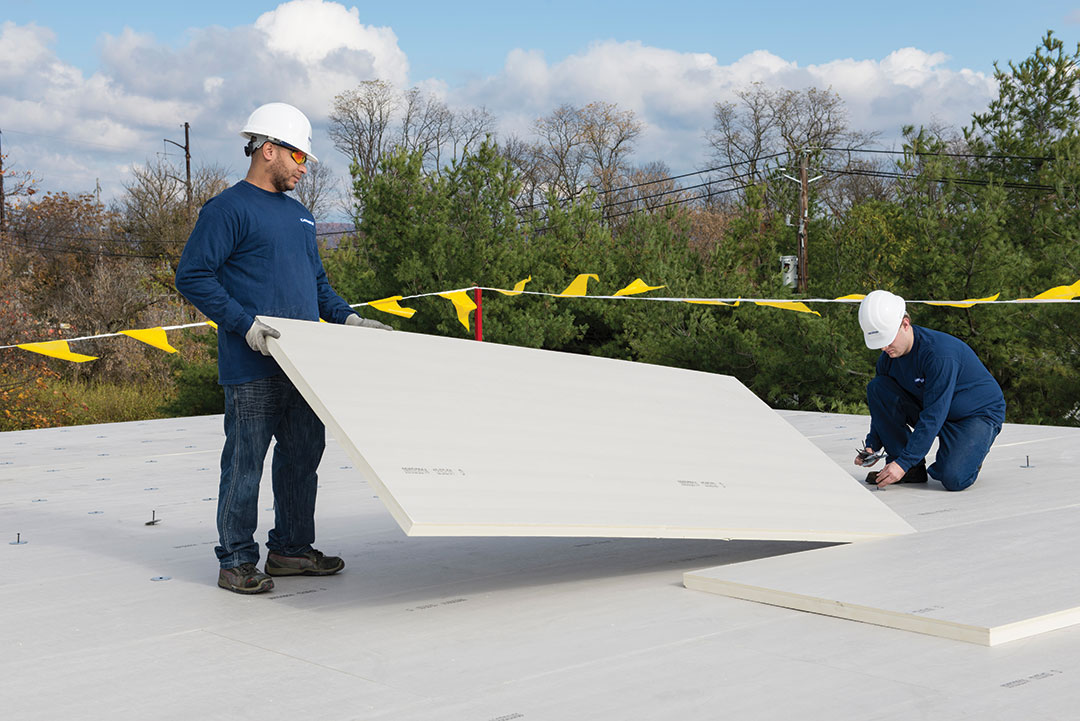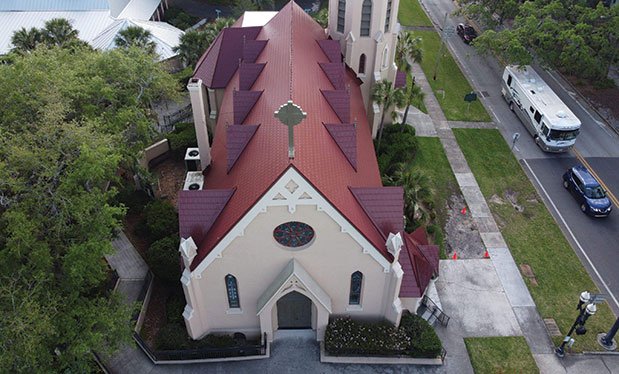
The roof is one of the largest building surfaces exposed to the external environment for most commercial buildings and can play a crucial role in a building envelope’s thermal efficiency. Consequently, many building standards and energy codes mandate the installation of energy-efficient roof systems to improve building envelope performance. To achieve an energy-efficient roof system and meet the demand for improved performance, roofing professionals can use insulation solutions such as polyisocyanurate.
Polyisocyanurate roof insulation boards are an energy-efficient choice for low-slope commercial roofing projects. With one of the highest R-values per inch when compared with alternative insulation products, polyisocyanurate can be used in new construction as well as reroofing projects on existing buildings to meet energy code targets while using less material. In addition to flat stock insulation boards, tapered insulation products and high-density roof cover boards complete the portfolio of polyisocyanurate roofing products that can deliver performance for any roofing project.
Project-specific needs
Polyisocyanurate roof insulation boards are manufactured with various facer types such as glass-reinforced cellulose facers and coated glass facers as well as aluminum foil facers typically used for wall applications. As a rigid foam board insulation, polyisocyanurate products have measured compressive strengths ranging from 16 to 25 pounds per square inch. This enables polyisocyanurate to resist deformation and maintain its shape under external load or forces.
Each of these insulation products delivers the requisite thermal resistance (R-value) as well as unique physical properties for different applications. Manufacturers produce polyisocyanurate roof insulation boards in a wide range of thicknesses and sizes, offering flexibility to roofing professionals looking to meet specific R-values. Typically, thicknesses range from 1 to 4½ inches with other options available upon request.

In terms of popularity, 2.6-inch-thick polyisocyanurate roof insulation boards are specified the most often. For reference, two layers of 2.6-inch-thick polyisocyanurate insulation deliver a total R-value of 30. This equates to the 2021 International Energy Conservation Code®’s required prescriptive minimum R-value for above-deck roof insulation for commercial buildings located in climate zones 4, 5 and 6 in the U.S.
In climate zones 2 and 3, two layers of 2.3-inch-thick polyisocyanurate insulation meet the IECC required prescriptive minimum R-value of 25. Climate zones 0 and 1 are unique because the IECC prescriptive minimum R-value of 20 (two layers of 1.75-inch-thick) is required for all occupancies other than Group-R, which must meet an R-value of 25. In northern parts of the U.S. (climate zones 7 and 8) where a minimum prescriptive R-value of 35 is required for insulation in above-deck roof applications under the 2021 IECC, two layers of 3.1-inch-thick polyisocyanurate roof insulation boards will provide a total R-value of R-36. Thicker products, such as 4-inch-thick boards, may more commonly be used as infill panels for tapered insulation systems.
Multilayered insulation
Installing rigid insulation boards in multiple layers with the joints of each layer staggered is a good practice rooted in building science fundamentals and required by current model energy codes. Polyisocyanurate insulation boards installed in a multilayered system with staggered joints can yield the following benefits:
- Reduced thermal losses through insulation joints, improving the overall energy efficiency of the roof system
- Reduced thermal bridging from fasteners when the top insulation layer is adhered
- Reduced air leakage to minimize heat transfer
- Reduced moisture migration from a building’s interior into the roof system, which helps prevent condensation issues
- Reduced vulnerability for membrane buckling, ridging and splitting, promoting the longevity of the roof system
High-density roof cover boards

High-density polyisocyanurate cover boards are manufactured in either ¼- or ½-inch thicknesses. High-density polyisocyanurate cover boards are 66%-80% lighter than gypsum products, which makes them easier to handle and install. Additionally, high-density polyisocyanurate cover boards offer two to five times higher R-value than gypsum products. A ½-inch-thick high-density polyisocyanurate cover board will have an R-value of R-2.5. Together with their high compressive strength, these high-performing cover boards help extend the life span of a roof assembly by increasing the roof’s ability to resist weather events and service traffic.
Environmental effects
Insulation can go beyond thermal performance and information about a product’s environmental effects can be crucial for a project team’s sustainability goals. To ensure transparency during polyisocyanurate’s manufacturing process, the Polyisocyanurate Insulation Manufacturers Association has published third-party verified, Environmental Product Declarations for polyisocyanurate products manufactured in the U.S. and Canada.
One EPD provides life-cycle analysis for polyisocyanurate roof insulation with glass-reinforced facers and coated glass facers (ASTM C1289, “Standard Specification for Faced Rigid Cellular Polyisocyanurate Thermal Insulation Board,” Type II, Class 1 and 2 products). This EPD includes an analysis of the energy and carbon-saving potential of polyisocyanurate products used in roof system replacements. It also shows how building teams can offset the effects of the insulation’s manufacturing process through the energy savings accrued by using energy code-compliant levels of polyisocyanurate insulation as part of a reroofing project.
Furthermore, raw materials can significantly influence a product’s environmental effects, and polyisocyanurate manufacturers select inputs with an eye toward reducing these footprints. Closed-cell insulation products similar to polyisocyanurate use blowing agents to increase thermal resistance and facilitate the manufacturing process. Although certain blowing agent options historically came with a high global warming potential, polyisocyanurate manufacturers have long used pentane or pentane blends in their product formulations. These hydrocarbons exhibit zero ozone-depletion potential and a global warming potential value of less than one, ensuring compliance with federal and state regulations.
Polyisocyanurate products also may be manufactured with raw materials that use recycled content (most commonly as part of the product’s facing materials).
Challenges
Reroofing projects can present opportunities to improve energy efficiency performance by enhancing the level of insulation installed as part of roof assemblies. Data from the Energy Information Administration’s Commercial Building Energy Consumption Survey suggests only 14% of existing commercial buildings have been renovated since 2000. Given that current energy codes require more stringent levels of insulation than codes in place before 2000, a significant number of existing buildings are underinsulated when compared with modern energy codes and performance standards.
To realize greater energy savings, designers and roofing contractors can integrate additional insulation during roof system replacement. In fact, modern energy codes require roof system replacements to comply with a building’s thermal envelope insulation requirements for new construction. However, certain roof system replacement projects can present unique challenges to increasing insulation above existing levels or to meet energy code requirements. These challenges can include low curb or flashing heights, existing roof drainage configurations, or door thresholds and window sill heights that sit too close to the finished roof surface. Installing additional insulation may compromise these conditions.
The challenges associated with bringing an existing roof into compliance with code-required R-value levels are not roadblocks; rather, they can be opportunities to improve building performance. In many instances, the use of a polyisocyanurate tapered insulation design, an optimized insulation design or the addition of other features such as roof drains, may be used to improve roof system configuration and accommodate the required levels of roof insulation. A tapered insulation design may allow contractors to increase the level of insulation on select portions of the roof area while installing less insulation in areas affected by features such as low door thresholds, curbs or flashing heights.
Additionally, tapered insulation designs can be used to address roofs that lack proper slopes for effective drainage and where structural modifications may be impractical or cost-prohibitive. It is important to remember a roof system’s ability to shed or drain water effectively has less to do with the roof membrane and more to do with the overall system’s ability to control the flow of water and direct it toward proper points of drainage.
To ensure appropriate roof system performance and longevity, tapered insulation designs offer unique and flexible approaches for addressing water management on roofs. Using tapered roof insulation can help contractors eliminate the risk of ponding water and extend a roof’s service life.
Additional resources
Energy-efficient roof systems are crucial components of a high-performing building envelope. Materials such as polyisocyanurate roof insulation can help roofing contractors deliver thermally efficient and durable roofs. Furthermore, knowing and applying installation best practices can help roofing contractors maximize performance and longevity throughout a roof system’s service life. In doing so, not only can they add more value to their customers’ buildings but they also deliver high-quality workmanship, which can help them remain competitive.
For efficient and durable roof systems, project teams should always consult manufacturers’ installation instructions. PIMA maintains a library of technical bulletins to support the use of polyisocyanurate roof insulation.
To access technical bulletins about polyisocyanurate roof insulation, go to polyiso.org.
MARCIN PAZERA, Ph.D., is PIMA’s senior technical director.



